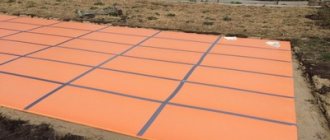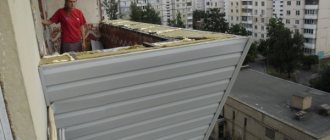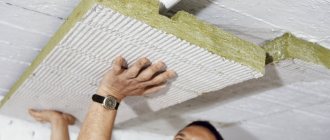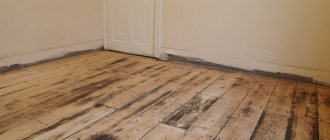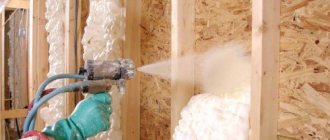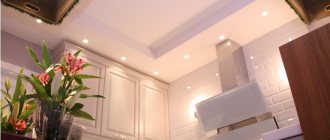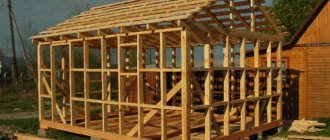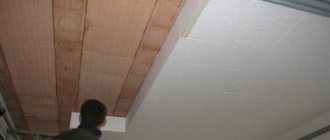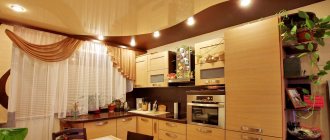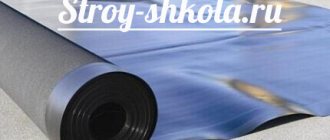During the cold season, any house loses heat due to leaks at the joints of building structures, cracks in windows and doors, as well as due to thermal radiation from walls, floors and ceilings into the surrounding space. At the same time, ceilings and roofs account for 15 to 45% of all heat losses. Therefore, the ceiling must be insulated, eliminating heat loss due to the release of heated air and due to heat transfer. Most insulation methods do not require expensive equipment or special qualifications of workers. They are quite capable of doing the work of insulating a house with their own hands.
In addition to the most important task - heat preservation - thermal insulation work also solves one more - maintaining optimal humidity. For this, in addition to insulation materials, vapor barrier and waterproofing membranes are used to prevent condensation from accumulating on ceilings and walls. Semi-permeable membrane films allow water vapor to pass through them in one direction and do not allow moisture to pass through in the opposite direction.
General scheme of ceiling and roof insulation
Ceiling and roof insulation schemes
From the point of view of insulation, all roofs are divided into two types:
- Warm. Under the roofing material there are several layers: vapor barrier, ceiling insulation and waterproofing. They are held in place by battens - spatial structures attached to the rafters. The ceiling of attic rooms is insulated according to exactly this scheme.
- Cold. They have a layer of roofing material and a load-bearing structure and a layer of vapor and waterproofing placed underneath them. The air gap in the attic is an additional barrier to heat loss. The ceiling located under the so-called cold roof must be insulated and waterproofed.
Features of ceiling insulation
The main feature of insulating a flat ceiling is the inability to arrange condensate drainage, as is done for sloping roofs. Therefore, almost all insulation solutions are aimed at removing water vapor upward, ensuring its unhindered passage through all layers.
Cold overlap
How to properly insulate a ceiling in a cold attic? Air gaps are left above a cold or heat-conducting ceiling (for example, concrete). The first, auxiliary between the vapor barrier film and the insulation, comes into effect when there are large temperature changes and heavy condensation. It must be well ventilated. It is easier to make the main gap between the insulation and the waterproofing layer ventilated - just leave a small gap around the perimeter. It is preferable to insulate a cold ceiling both from above and from below. The insulation used for the ceiling located under a cold attic must be moisture resistant.
Warm ceiling
A floor made of materials with low thermal conductivity, such as wood, is called warm. Such floors, which themselves serve as a heat insulator, need only be insulated from above. Even if condensation forms during extreme temperature changes, it will be absorbed into wooden structures without changing their properties, and will subsequently evaporate. As a rule, this process is invisible to the inhabitants.
The vapor barrier is laid on the ceiling without a gap, then the insulation is laid. The air gap between the thermal insulation layer and the hydrobarrier membrane should also be left and will provide the possibility of its ventilation.
Insulation of ceilings in a house with mineral wool
Mineral wool is a fibrous heat insulator produced in the form of rolls or slabs. The composition of the material is determined by GOST R 52953-2008, and there are three types of mineral wool - stone, slag and glass (better known as glass wool). Let's take a closer look at them.
Prices for mineral wool
mineral wool
Stone wool is made from various rocks, such as diabase or gabbro, and also contains clay, limestone, dolomite and a binder containing formaldehyde resins. The average thermal conductivity coefficient of stone wool is 0.08-0.12 W/(mK). In our case, the lower its value, the more suitable the material is for the role of insulation.
Unlike stone, slag wool is made from blast furnace slag and other metallurgical waste. The thermal conductivity coefficient averages 0.47 W/(mK), which, combined with its high hygroscopicity (the ability to absorb moisture), makes slag wool an unsuitable material for insulating ceilings. In addition, it has residual acidity, so it should be kept away from metal pipes, beams and other products.
Slag
Glass wool ranks first in terms of thermal insulation quality among mineral wools - 0.03 W/(mK). It is also distinguished by a very low price. The disadvantages include the fact that particles of this material can cause harm to humans if they get on the skin, eyes or lungs. But this is, to one degree or another, characteristic of all types of mineral wool, therefore, when working with them, it is necessary to wear gloves, safety glasses, a respirator mask and closed work clothes.
The main advantage of all types of mineral wool is that this material is very convenient for transportation, carrying and installation, as it is light in weight. In addition, it is non-flammable and at very high temperatures can only sinter (while losing its thermal insulation properties)
And it is especially important for country houses that mineral wool is not an attractive place for rodents, insects, fungi or mold
The most famous manufacturers of this material are Ursa and Paroc
If quality is important to you, then when going to a hardware store, look for mineral wool from these companies
When choosing, also pay attention to the density of the material - the ceiling may not withstand samples of mineral wool that are too dense and heavy
The insulation process should begin by determining the area of the ceiling, because first you need to calculate how much mineral wool, vapor and waterproofing films you will need. Next, the technology of external ceiling insulation will be considered. If you require internal insulation, follow the same instructions, but swap the layers of hydro- and vapor barrier.
Glass wool prices
glass wool
Calculation of ceiling area
In addition to the insulation itself, you will need wooden boards or a metal profile, tools for cutting mineral wool, protective clothing and equipment (gloves, a respirator and goggles) and fasteners.
- First, we lay a vapor barrier film on the floor of the attic, making sure that there are no breaks in it. The laying should be overlapped, the seams should be taped with special vapor barrier tape.
- On top of it we install a lathing made of wood or galvanized profile. The distance between the slats should be several - a couple of centimeters - less than the width of the sheet or roll of mineral wool. This way the insulation will fit more tightly. The height of the lathing should exceed the thickness of the thermal insulation layer by 1-2 centimeters in order to subsequently ensure air circulation between it and the waterproofing.
- We unpack the mineral wool and place it in the space between the slats. If the material is laid in several layers, the next layer should overlap the seams of the previous one.
- We attach the waterproofing to the sheathing on top using a furniture stapler. In this case, as mentioned above, there should be a small space between it and the mineral wool for air circulation.
External ceiling insulation with mineral wool
Barriers and membranes
Vapor barriers
Vapor barriers are needed to prevent water vapor from passing through them. For their production, polypropylene films with a thickness of over 55 microns are used.
Polyethylene is unsuitable as a vapor barrier - over time, due to temperature fluctuations, it cracks and begins to let vapor through. However, if you solder a layer of polyethylene and a layer of foil, you get a high-quality vapor barrier.
Folgoizols are also supplied with a layer of fibrous nonwoven material such as padding polyester. This layer collects moisture from the insulation and carries it away through capillaries. If it is present, there is no need to create an additional air gap above the cold ceiling.
Membranes
Multilayer reinforced membrane materials allow vapor to pass in one direction and retain moisture in the opposite direction. The reinforcing mesh layer ensures the strength of the film, prevents it from sagging and guarantees a constant size of the main air gap.
Membranes with a reinforcing layer
How to insulate a ceiling in a private house
Effective materials with which you can insulate the ceiling yourself:
- Mineral wool. It has excellent thermal insulation characteristics. The main disadvantage is its susceptibility to moisture (hygroscopicity), so mineral wool should be protected as much as possible from exposure to humidity.
- Foam plastic is a polymer insulation. It is resistant to moisture, fireproof, and easy to work with independently.
- Expanded clay. Loose mass on a clay basis with low weight, non-flammable. Expanded clay is environmentally friendly, resistant to moisture, and has decent thermal insulation qualities. During operation, expanded clay does not harbor harmful rodents and insects.
- Penoizol. The polymer composition of penoizol ensures maximum service life
- Ecowool. Made from cellulose. Eco-friendly, provides decent thermal protection of the ceiling.
- Sawdust. The main advantages of insulation: minimal weight per floor, high level of environmental friendliness, minimal costs. The main disadvantage is the high risk of fire. Also, the disadvantages include the possibility of rotting/drying out. Sawdust is a favorable habitat for rats and mice.
Insulation materials
What is the best way to insulate a cold ceiling? The main thermal insulation materials used for insulating ceilings can be divided into the following categories:
- Solid. Such materials consist of foamed plastics, are little susceptible to moisture, and are easy to install.
- Fibrous. Mats or rolls are formed from compressed fibers. Inexpensive, have good thermal insulation. Sensitive to moisture, when wet they lose their thermal insulation properties.
- Bulk. Traditional bulk materials - sawdust, expanded clay, etc. The cheapest ones have the weakest thermal insulation. Ecowool stands out separately - an expensive, but extremely effective material.
- Sprayable. Modern coatings made of foamed plastics. They are sprayed locally and do not form joints or seams. The best thermal insulation, very expensive equipment.
How to insulate the ceiling, everyone decides for themselves, based on their needs and capabilities.
Mineral wool
Rolled mineral wool
The most popular type of fibrous materials. Produced from several types of raw materials:
- Basalt wool from volcanic rocks. High strength and density, short hard fibers. High moisture resistance.
- Glass wool from recycled glass. Low strength, light and elastic, long elastic fibers.
- Slag from blast furnace waste. Low thermal insulation properties, low cost. Not applicable for residential buildings.
To insulate with mineral wool, no special equipment is required; the installation process is simple and quite fast. It is produced both in rolls and in slabs with insulation thickness up to 150 mm.
Mineral wool is harmful to health; during installation you must use a respirator, protective gloves and goggles.
Attention! If fibers get on the mucous membranes, respiratory or digestive organs, you should immediately consult a doctor.
After installation during use, mineral wool is completely harmless to those living in the house.
An important feature of mineral wool that must be taken into account when designing and installing is the large number of joints and junctions. They need to be done so that the gap is minimal, the slabs are laid against the guides and opposite each other. Half-centimeter gaps between slabs can reduce the effectiveness of the coating by a third.
Correct and incorrect installation of insulation
The thermal insulation properties of mineral wool are reduced until they are lost when the material gets wet. Therefore, it is necessary to ensure the removal of vapors and condensate.
Monolithic
The most suitable and popular material for thermal insulation of ceilings is polystyrene foam. It is produced in the form of 1200*600mm panels equipped with tongue and groove. This allows you to make high-quality joints during installation. In addition, cracks and gaps are sealed with polyurethane foam. The material is resistant to moisture and temperature fluctuations. Works great when insulating ceilings both outside and inside
Its disadvantage is low fire resistance. When burned, it releases substances harmful to health.
Insulation with polyurethane foam
Polystyrene foam, or polyurethane foam, is significantly cheaper than polystyrene foam, but has low strength and is prone to chipping. Suitable for insulating ceilings from the inside.
Types of insulation for ceilings
Among the main indicators for heat insulators are the following qualities:
- Protection from mechanical damage.
- Flexibility, ability to restore shape.
- Compressive strength at a fairly high level.
- Safety from an environmental point of view.
- Minimum flammability index, or its complete absence.
- High moisture resistance.
- Low thermal conductivity as possible.
You need to choose materials that are not too heavy. This is especially important in the case of old buildings that have not been renovated for a long time. Otherwise, the integrity of the structure is compromised; insulating the ceiling with your own hands in a private house will lead to other negative consequences.
Mineral wool
Three varieties are produced, divided by production raw materials:
- Glass wool.
- Slag-like.
- Basalt.
Almost all of these varieties have the same thermal conductivity, with a slight difference. Another thing is water resistance and environmental friendliness, fire resistance and density.
Basalt (stone wool)
Heat-resistant material that can withstand up to 700 degrees above zero. Compared to glass wool, it weighs twice as much.
Among the positive features:
- Moisture resistance.
- Environmentally friendly.
- No harmful effects on human health.
Only high prices per square meter can repel.
Glass wool
At temperatures up to +450 degrees, all the properties of this material are preserved without problems. One cubic meter weighs 130 kilograms. This is important for those who are interested in how to properly insulate a ceiling under a cold roof.
Pros:
- Lack of flammability.
- Good absorption of vibration and noise.
- No deformation throughout the entire storage period.
But there are also disadvantages. The material is able to absorb moisture, after which the original density noticeably decreases. Installation can also cause some problems, but now there are more modern versions, some of whose properties have noticeably improved. They simplify the search for an answer to the question of what is the best way to insulate the ceiling of a private house.
Slag
With a cubic meter weight of up to 400 kilograms, making the density the highest among similar materials. When heated to +300, the surface begins to melt.
Elastic insulation that allows installation even over curved surfaces. It can last up to 50 years if the owners took into account all the properties and rules during installation. But it is not intended for use on metal floors with high humidity or indoors.
Cork boards
Hypoallergenic products that are great even for bedrooms and children's rooms. This is a coating, texture and color that can be varied. You can apply additional designs and paint the surface with different compositions.
Cork is good due to the following properties:
- There are no requirements for additional surface leveling.
- Inertness towards moisture.
- Ability to hide minor defects on the ceiling.
Glue and hardware are used to secure the insulation. The type of installation is chosen depending on what material is used in a particular case. The presence of a cement base is one of the main requirements in this case. Any user can quickly figure out how to insulate the ceiling in a private house from the inside.
Ecowool
The Eco prefix is used to name material not only for advertising purposes. It is truly safe from an environmental point of view, because the composition includes cellulose for the most part.
The remaining 20% goes to various additives, including:
- Lingin.
- Boric acid.
- Antiseptics.
The addition of fire retardants provides protection from open fire. 0.038 W/(mK) – Thermal conductivity.
Ecowool is applied to the ceiling for insulation using a wet or dry method. The latter option allows you to save only 60-70% of the original properties. The material is placed in special “cells” on the ceiling, prepared in advance.
The second method is when ecowool is moistened and sprayed over the surface using special equipment. The insulation increases its adhesiveness when in contact with large amounts of moisture, so the fit becomes tighter. The only drawback is the need to use special equipment. Not everyone will understand how to insulate the ceiling in a private house with its help.
Extruded polystyrene foam
Often found in the form of slabs that are used on reinforced concrete floors. It is difficult to install. Special preparation is required to ensure that the work is completed without errors and losses in material, tools and surface quality.
In any case, the foundations require repair and leveling if the slab insulation is laid on the side of the cold attic. The so-called vapor barrier film is laid in the form of a pallet; it has sides that are curved at the edges.
Laying slabs when insulating the ceiling in a private house always proceeds freely. Seams do not require sealing when using Penoplex, which has a mounting chamfer. The opposite conditions are observed in the case of simple polystyrene foam.
Screed is applied to the slabs, but it usually remains partial. Everything is built on a base of gypsum fiber sheets, or filled with a cement-sand mixture, with the addition of a reinforcing layer.
For insulation, waterproofing must be laid in the case of filling with a special solution. Then the concrete milk will not penetrate into the insulation, and its properties will not deteriorate over time.
Spray polyurethane foam
This name was given to a type of plastic whose main properties were the simultaneous preservation of strength and lightness. Inside the structure of such materials there are special cells that are completely filled with gas. The result is a material with zero water absorption and low thermal conductivity.
Laying such thermal insulation requires the use of special equipment. Throwing liquid mixtures and materials in itself requires additional training from the craftsmen. The mass is applied while maintaining a high level of pressure. Foam is formed, due to which a seamless space is formed. The next layer is applied when the previous one is completely dry.
The liquid application option is especially popular, since it does not require additional processing and is capable of precisely repeating the surface topography. To fasten materials of this group, you will not need to build any other structures.
External application of thermal insulation is also acceptable in situations where other options are not suitable. A distinctive feature of polyurethane foam is its high resistance to moisture, which makes it possible to effectively insulate the ceiling in a private home.
Expanded clay
One of the bulk types of materials. In production, the method of firing low-melting clays or shale is used. Processing is carried out using a special drum that constantly rotates. The output is ceramic pellets of different fractions.
Numerous advantages explain the steady demand for the material among consumers:
- Simplicity and ease of installation, all work can be easily done with your own hands.
- There is no need to be afraid of the appearance and spread of rodents.
- Biologically stable.
- Environmental Safety.
- Use in cement mortars.
- Light weight granules.
- Frost resistance at a high level.
- Resistance to temperature changes.
- Fire resistance class NG.
- Long service life.
- Relatively low prices.
The large thickness of the layer along with the high level of moisture absorption are the only disadvantages that can be easily overcome when using this ceiling insulation for a cold attic.
Coarse-grained granules have the best properties for ceiling insulation.
In practice, it has been proven that the best results are produced by layers that contain the following components:
- 60-70% granules of medium and fine fraction.
- Expanded clay sand with a diameter of 2-3 millimeters.
The sand is poured in first to form a cushion for the other materials.
Might be interesting
Vapor barrier
Technologies and materials for effective thermal insulation of floors in…
Vapor barrier
Vapor barrier and waterproofing, is there a difference?
Vapor barrier
Features of vapor barrier of a wooden building
Vapor barrier
Vapor barrier in a bathhouse, how to do it correctly?
Sawdust
Here are the main advantages characteristic of such insulation on the ceiling in a private house:
- Long service life.
- Easy to install.
- Affordable price.
- Hassle-free access to material.
- Clean from an environmental point of view.
Medium-sized sawdust is best suited for thermal insulation inside a private home. Large-fraction materials cannot boast of sufficient thermal insulation, and small materials are difficult to work with.
The best option is sawdust, which appears as waste after carpentry. They do not require additional drying and have a low level of humidity. When using, you don’t have to worry that the material will begin to rot.
But the material must rest for at least a year before operation begins. Then the likelihood of rotting becomes even less, the mineral material is more effective.
Sprayed and bulk materials
Sprayed materials are very effective, have no joints or seams, and almost do not burn. They can be effectively sprayed into hard-to-reach areas and cavities, providing thermal insulation where other materials can only be placed with partial dismantling of building structures.
The main disadvantage is the extremely high cost of the equipment and the highly qualified operator. This hinders the widespread adoption of this promising method.
Ecowool
Very promising as bulk and sprayed insulation for roofs and ceilings. Occupies an intermediate position between sprayed and bulk materials. It is made from recycled paper and has the same thermal conductivity as mineral wool. Fibers with the addition of glue are fed to the surface or into the cavity under slight pressure and harden there. When wet, it partially loses its properties, but after drying they return.
Additives in ecowool make it low flammable, environmentally safe and unattractive to rodents and mold. The material does not cause allergies and does not contribute to the development of cancer.
Methods for laying ecowool
Applying ecowool does not require special qualifications, and installation is a little more complicated than a vacuum cleaner. One of the few drawbacks is the requirement for application temperature: not lower than +23°C
Expanded clay and foam glass crumbs (foam crumbs)
When filling with expanded clay or foam crumbs, it is necessary to take into account that its thermal insulation properties are low compared to more modern materials. Therefore, a significantly thicker layer will be required.
Expanded clay - traditional bulk insulation
A few advantages of the material are its low cost, moisture resistance and non-flammability.
Expanded clay is used in budget solutions as an outer layer, while internal thermal insulation is performed with mineral wool
Scheme of two-layer insulation with expanded clay and mineral wool
Sawdust and shavings
These materials can be attractive due to their low cost; sawdust and shavings can be obtained completely free of charge at woodworking factories. Wood shavings have a high fire hazard; sawdust burns much worse.
Before laying, it is recommended to dry them well, and during layer-by-layer laying, moisten them with solutions of boric acid and borax.
Work order and basic principles of insulation from the inside
Insulating the ceiling in an apartment is somewhat different from the same operation in a private house. Here, the height of the premises will, as a rule, be lower, and different materials must be used.
If the ceiling slab is fairly flat, you can do without constructing a special frame for the insulating layer. This solution is especially relevant when using polystyrene foam or expanded polystyrene as insulation.
These materials are simply glued to the floor slab with tile adhesive. You can use other adhesives. The main requirement for them is high joint strength and the possibility of use with foam plastic.
Additionally, slabs of such insulation are fixed with special dowels having a wide plastic cap.
To avoid condensation, it is necessary to carefully ensure that the seams and joints of these glued materials are filled with polyurethane foam.
After gluing, the outer side of the insulating layer is either plastered or hidden behind the suspended ceiling.
With mineral wool it will be much more difficult. Although some of its varieties can be glued to the ceiling, the outer layer of finishing needs to be attached to something, and it cannot be attached to cotton wool. It is necessary to construct a frame foundation.
With its construction, the insulation of the ceiling from the inside of the apartment with mineral wool begins. It’s worth talking about all the intricacies of this process separately. Moreover, the basic principles will be the same for the construction of frames for any type of insulation.
Ceiling insulation
Let's consider the process of insulating the attic ceiling with mineral wool. The technology varies based on the specific designs and circuits chosen.
Outside
The simplest and fastest method of thermal insulation is inter-beam. If the ceiling is made of solid boards, a vapor barrier must be placed around the beams or film wraps must be made on them. If the ceiling is made of thin lining or slats, a foil vapor barrier film is attached below the beams, along the ceiling.
Methods for insulating a wooden ceiling from the attic
A complete insulation scheme requires significantly more labor, materials and time, but it is also much more effective. An above-beam double layer of slabs is added to the inter-beam layer of rolls or mats. The layers must be laid overlapping.
How to insulate a cold ceiling from the inside
When choosing a method of thermal insulation of the ceiling from the inside, you need to understand that any of them will reduce the height of the room. Minimal height loss will occur in the case of installing a suspended ceiling or suspended ceiling made of plasterboard. In this case, thermal insulation boards can be placed between the guide metal profiles.
Fastening basalt wool to disc dowels
If a suspended ceiling is not planned, then insulation boards can be attached in various ways:
- Still, make guides from wooden slats or metal profiles.
- Secure the panels with special disc dowels. For one mat measuring 1200 * 600 mm you need at least 4-5 dowels
- Glue to the ceiling with mastic.
A reinforced mesh is glued to the lower part of the insulation, and leveling primer and layers of paint are applied to it.
No attic
When insulating buildings without an attic, in addition to solving the problem of heat preservation itself, it is necessary to ensure the removal of excess moisture, both contained in the air in the form of vapor and condensing on cold surfaces.
Scheme for buildings without an attic
A vapor barrier is laid under the light ceiling, and a layer of thermal insulation material is laid on it. It is necessary to provide two ventilated gaps - between thermal insulation and waterproofing and between waterproofing and roofing material. You need to install vents along the ridge or simply lift the ridge cap so that the air can escape freely.
Choice of insulation
Expanded clay and vermiculite are natural bulk insulation materials for attic floors.
Several types of materials are used to insulate ceilings. Each of them has advantages and disadvantages. To make the right choice, you should understand their features.
Bulk
Materials of natural origin are considered environmentally friendly:
- Expanded clay. The most affordable insulation material, which is light, round, dark brown granules made from a special type of clay. Since expanded clay has average thermal insulation characteristics, if it is used, a layer of at least 0.2 m is required. The main advantage is its strength, which allows it to withstand a concrete screed. However, expanded clay is afraid of moisture and has considerable properties due to its large volume. If used, a durable floor is required.
- Vermiculite. This is a rock that, after firing, becomes porous and retains heat well. Vermiculite is lighter in weight than expanded clay, but much heavier than mineral wool. Based on practice, vermiculite is the best option among bulk insulation materials. It does not burn, is not afraid of moisture, and does not allow air to pass through.
- Ecowool. Appeared on the market recently, it is a product of recycling waste paper. To prevent cotton wool from flaming, borax is added to it. When using, it should be taken into account that ecowool shrinks slightly (about 15%). One of its advantages is lightness. Ecowool can withstand any type of flooring.
- Sawdust. Their cost is pennies, but there is a small nuance. The material must lie in a dry room for more than a year. To protect against rodents and fungus, sawdust must be mixed with slaked lime in a ratio of 10:2.
- Coal slag. The weight and thermal conductivity are equal to expanded clay, so it will also have to be poured (0.2 m). There is a lot of dirt from the slag and it absorbs moisture.
To prevent the insulation from shrinking over time, during installation it is worth using bulk materials of different fractions.
Rolled
Mineral wool must be purchased with impregnation against moisture.
The main advantage of such materials is the ease of laying between the joists.
- Linen mats. They look like mineral wool. They can absorb moisture, but after final drying the volume is restored. Impregnation protects the insulation from rodents and prevents fire.
- Glass wool. It occupies a leading position in the quality of thermal insulation among all types of mineral wool. Another advantage of insulation is its low cost. However, working with glass wool is unsafe: particles of the material can damage human skin and, if they get into the eyes, cause serious injuries. Therefore, working with glass wool requires the use of protective clothing.
- Mineral wool (basalt). It is a non-flammable material, but is easily exposed to moisture and has a fibrous structure. The insulation is popular due to its thermal insulation properties and has a long service life.
The widespread use of cotton wool in residential buildings is explained by environmental safety: it is produced only from materials of natural origin.
Slab
Basalt wool slabs on the floor can withstand heavy loads if you plan to equip an attic.
They can only be insulated on flat surfaces. If there are defects, it is better to eliminate them immediately.
- High density mineral wool boards. They are used in wooden houses, for insulation in the kitchen and in the steam room (with a density above 100 kg/m³). If a vapor barrier is used, such slabs hold their shape for a long time. The higher the density, the longer the thermal insulation will serve.
- Natural cork. It belongs to environmentally friendly and effective insulation materials and is not cheap.
- Styrene based boards. Polystyrene foam or expanded polystyrene is one of the most convenient insulation materials used for thermal insulation of surfaces. It creates excellent protection from the cold and does not harm health. When installed correctly, foam plastic retains its properties for a long time.
Any type of insulation cannot be squeezed or pressed. In this case, it loses its characteristics.
Special cases
Let's look at a few special cases
In an apartment building
Apartments on the top floors of apartment buildings are known to be cold. Especially if the builders performed thermal insulation of the ceiling in violation of the technology. Any independent work in the attic of an apartment building is illegal; it is better to spend time complaining to the construction or operating organization and forcing them to fulfill their obligations to ensure normal temperatures. But the claim process is not a quick process, and the rooms are already cold today.
However, you can quickly and inexpensively insulate the ceiling from the inside and do it yourself. You will have to “please” your neighbors by drilling numerous holes in the ceiling for dowels, but the result is worth it.
Ceiling insulation in an apartment building
Another drawback will be a reduction in the height of the rooms by 4-5 cm, and around the perimeter of the ceiling - up to 40 cm. But heat is more expensive.
A system of guides made of wooden slats or a metal profile 4 cm high is installed on the warm ceiling. Sheets of foam plastic 30 mm thick are laid between them and attached to the ceiling with disc-shaped dowels.
After this, a foil vapor barrier is attached along the lower edges of the guides. Slopes with a radius of 40-40 cm are made along the perimeter, ensuring a smooth connection between the planes of the lines of the false ceiling and walls. At the last stage, sheets of moisture-resistant drywall are attached. Curvilinear slopes are covered with foam chips, starting from the short sides of the room. Ecowool is also suitable for this.
Attic
A residential attic must be insulated. Insulation of a non-residential attic will not hurt either - this will be an additional barrier to the cold on the residential floors. How to reliably insulate the ceiling in a residential attic? The most common scheme is insulation with mineral wool or polyurethane foam slabs laid between the rafters. For vertical walls, you will need to take special cotton wool with a low shrinkage coefficient.
Attic thermal insulation diagram
Particular attention will need to be paid to vapor barrier. In an already built house, the space under the ridge is not always available. In this case, ecowool can help out - it can be blown through temporary technological holes, which are then sealed with polyurethane foam.
Garage and bathhouse
The roof of a garage is often supported by metal I-beams. When installing guides for insulation, drilling holes from bottom to top in a steel beam is inconvenient, so the method shown in the figure is used. Thermal insulation boards are laid in two overlapping layers. Instead of fibrous materials, you can try ecowool. In this case, you can do without foil insulation, and instead lay kraft paper on the false ceiling.
Installation diagrams for bathhouses and garages
For the bathhouse, a standard thermal insulation scheme is used. Increased room humidity requires the use of basalt wool - insulating the ceiling of a building with glass wool is not recommended. Particular attention should be paid to the quality of ventilation of the gaps. Ecowool must be moistened with glue. If a bath ceiling is insulated, working from the attic side, bulk materials such as sawdust and shavings are often used.
How to insulate the ceilings and attics of private houses?
When building private houses, everyone wants to save money. But no one will dispute that cheap building materials are not effective or have a limited service life. It is better to master installation technology, where available, in order to save on installing insulation yourself.
Attention: The more technologically advanced each stage of construction is carried out using high-quality materials, the longer the house will last without requiring major repairs. This is the essence of saving for the future.
Any construction supermarket will offer a complete list of insulation materials that are used during the construction of a roof or after completion of rough work.
They are available in different forms:
- rolled materials;
- porous briquettes;
- sheet insulation;
- sprayed two-component mixtures;
- bulk materials;
- fiber insulation;
- foil wrapper.
The choice of insulation for the ceiling of a particular building depends on the type of surface and temperature conditions in the interior.
In this case, we are talking mainly about external insulation - attic or attic floors (on the other side of the ceiling of living rooms in residential buildings). For example, they use materials that are not suitable for energy saving methods in a bathhouse where there is a high level of humidity, and vice versa.
In some cases it is necessary to use special equipment. You can’t do without it when spraying with polyurethane foam.
It is much easier to insulate the joists with sawdust or expanded clay (of any fraction). They belong to bulk materials that do not require complex installation.
Apart from leveling, nothing needs to be done with them; then the substrate and cladding are laid, if this is a residential attic. For an empty attic, you can leave bulk materials without any fastening.
Tip: In some areas, bulk insulation is free. In coastal areas, this is dry seaweed that a storm throws onto the coast. In the area of the sawmill and wood processing enterprises there is a lot of sawdust, shavings and crushed bark.
Internal insulation of the attic along the beams and rafters - laying mineral wool with large briquettes, but the floors (the reverse side of the ceilings) must be insulated.
Worker skills and tools
Popular insulation methods do not require expensive equipment or high qualifications. For insulation, a home craftsman will only need general construction skills and ordinary tools:
- knife
- hammer
- screwdriver
- hacksaw
- stepladders
- roulette
When installing the guides, it is best to call an assistant. Help with cutting and laying rolled materials would also be helpful.
Before starting work and purchasing materials, it is necessary to make a sketch drawing. This will help you avoid making mistakes with dimensions and correctly calculate the amount of materials purchased.
